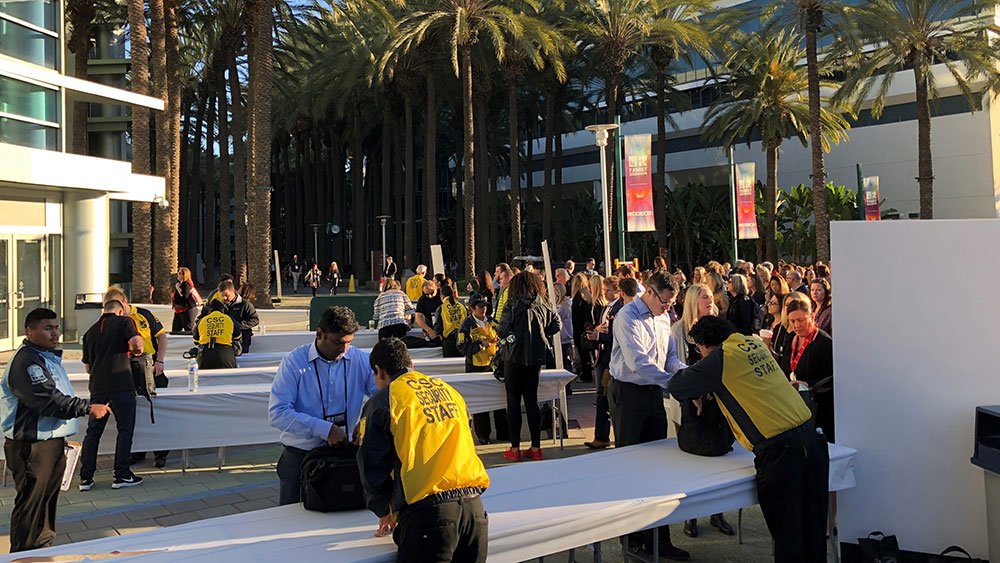
Before any event, staff members at Keller Williams are briefed on the emergency plan. (Handout)
Last Oct. 3, Americans received the first “Presidential Alert” to their cell phones — a test text of one of the Federal Emergency Management Agency’s three Wireless Emergency Alert System alerts meant to warn citizens about a national crisis.

Andre Lico
Following the alert, news organizations asked security experts to weigh in on its effectiveness. Some advised that while the alert might seem like a good idea as a test, using an alert in a real emergency could actually cause more harm than good — triggering panic or arousing curiosity in people that would distract them from acting safely and appropriately.
Andre Lico, CMP, events manager for Austin, Texas–based real-estate franchise Keller Williams, and developer of the organization’s risk-management program, takes a more middle-of-the-road view about text alerts. Sending emergency alerts can be helpful and even life-saving when it comes to meetings and events, he said, providing that the right messages are sent to the right people.
“We have found that text messages can be a good resource for a small number of people,” Lico told Convene, “and for a select demographic.” By that, he means event and venue staff. “In our experience, texting can be used for people that already have an idea of what to expect or have been briefed about potential emergencies and how they should react.”
Strength in Numbers
Lico, who created a “rudimentary” risk-management program for Keller Williams in 2016, said that he works regularly with an outside security consultant to continuously expand upon the organization’s ideas on how to best inform and protect attendees. And that direction, he said, should always start at the top — from the individuals organizing, overseeing, and working the event.
The most important step toward creating an effective risk-management plan, Lico said, is to make sure you have a well-informed staff. Lico’s core events team includes 13 individuals who are the first to be notified of an emergency situation, and have been prepped on how to appropriately respond. With the help of the security consultant, Keller Williams’ other 300 staffers who regularly work the organization’s events — some of which are attended by 17,000 people — are additionally briefed on proper procedures in case of emergency.
“So we have 300 people that the attendees should be able to rely on — that it’s 300 people that should know how to properly address or at least [advise on] what the next course of action should be,” Lico said. “Even if they may not be the best person to address something, they know how to get in touch with me or with one of my colleagues.”
Emergency Services
In a real emergency, whether it is an active-shooter situation or a case of severe weather, Keller Williams would rely heavily on text alerts, and would send three different messages to different groups at the event.
One of the alerts would be an intentionally vague message to attendees, along the lines of “‘Please leave the building through the marked exits and follow instructions of the emergency personnel,’ or something very basic and very clear without much detail about what the actual emergency might be, just so we can get them to a safe place first and quickly,” Lico said. “We have a set of preloaded messages on the app that one of my colleagues manages, so we create those messages on the front end with the help of our consultant and depending on what the emergency is, we just trigger one of them to go out [to attendees].”
Attendees ideally come to a Keller Williams event prepared, as the organization’s risk-management plan is made available on the event app, Lico said, “and called out as a resource in communications leading up the event.”
It’s likely, however, that many attendees have not taken the time to read the plan, so staff members take their places at strategic areas at the event venue, ready to provide directions to attendees at any given moment. This is especially important given that “texts can get lost in the myriad of other messages people receive,” Lico said, “making it less effective when trying to communicate an emergency.”
Staff members would all receive an alert with greater detail than what attendees receive through InitLive, a staff and volunteer management app all staff members are required to download. Their alert would include details on the crisis and instructions on next steps and how to answer attendee questions, but would also be based off of pre-loaded app messages that can be triggered at a moment’s notice.
Lico’s event team would receive an even more detailed message, typically through WhatsApp, which Lico said is usually the most reliable platform to use on site. This message would provide the team with the authority to carry out specific tasks that they would have already been informed of prior to the event.
“So, if it’s the person that’s working backstage with the production crew, she has a certain set of guidelines, I have my own, and so on,” Lico said. Each person, he said, already knows what their instructions are ahead of time and when they receive the emergency alert, they know it’s time to activate their plans.
“What everyone is craving and what they need the most is instructions,” Lico said. “I think everyone just wants instructions — how to be safe and how to act at that point if you hear a loud noise or if there’s anything that happens. People just want know what to do and who they can rely on for help.”
Casey Gale is an associate editor at Convene.

Security at Keller Williams’ 2018 Family Reunion event included a baggage check. (Handout)
Dressed to Save
Should there be an emergency during a Keller Williams event, attendees would need to rely on staff members to shepherd them to a safe location. The organization therefore works to make those employees as easy to recognize as possible.
“The message that we always send out in the ‘Know Before You Go’ emails and anything that we send to attendees before the event,” Keller Williams’ Andre Lico said, “is if you need assistance, always locate uniformed personnel or any of our staff members.” The communications include details about how to find the staff assigned to help in the event of an emergency, including how they will be dressed. By wearing matching T-shirts as well as distinctive name badges, Lico said, the 250 Keller Williams staff members are easy enough to spot in a crowd.
